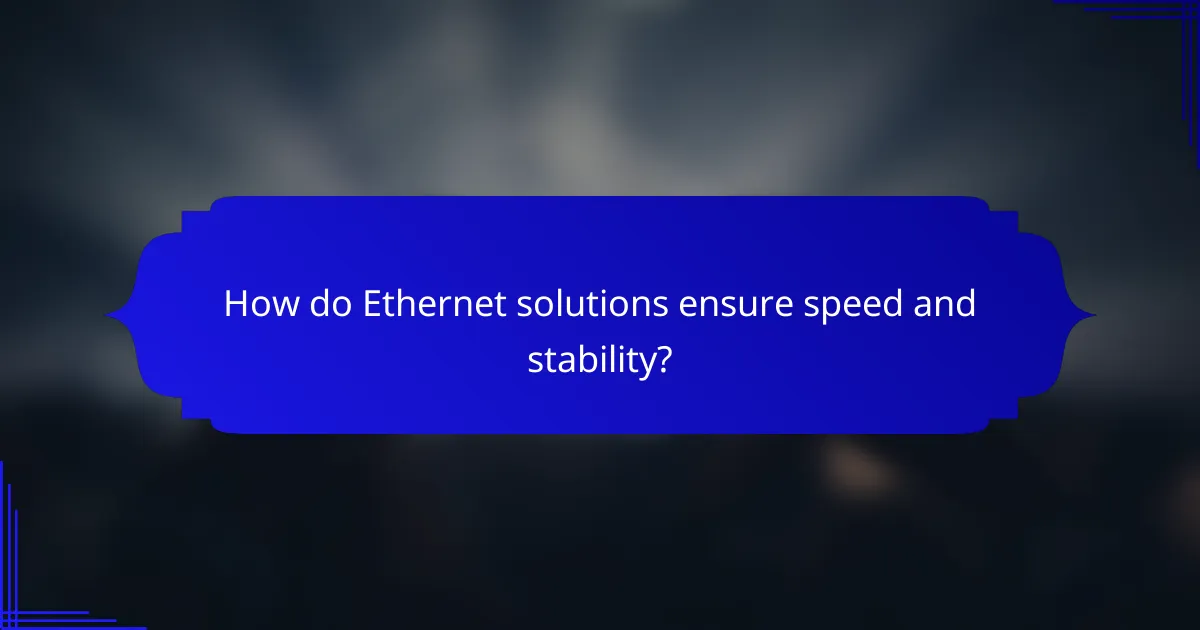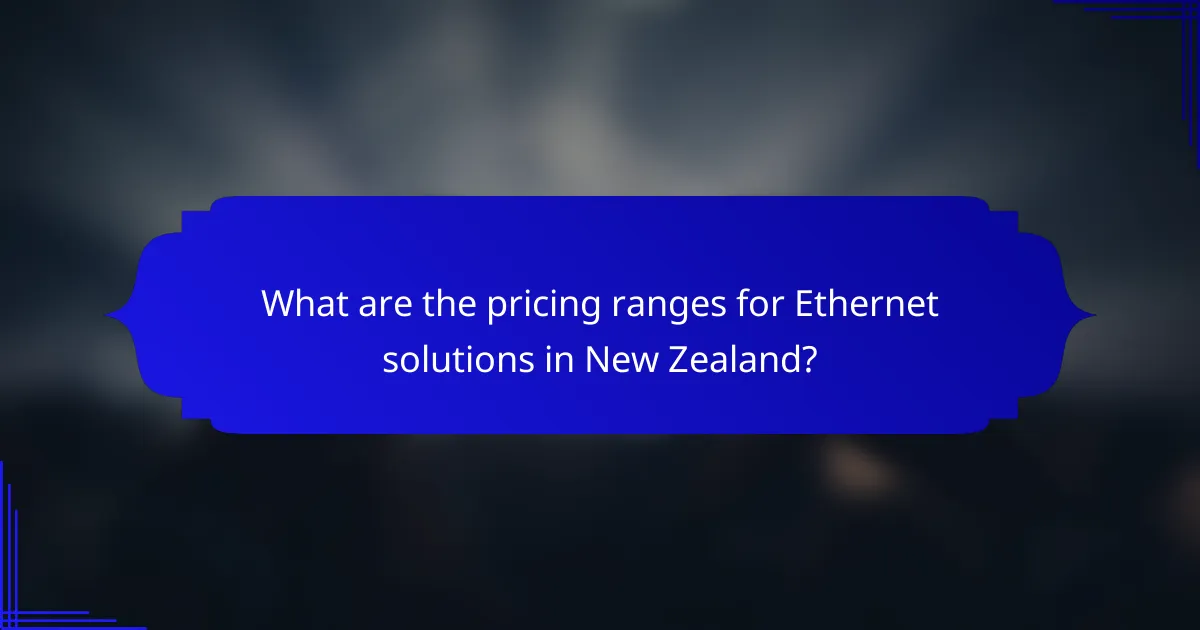Ethernet solutions provide a robust framework for networking, offering high-speed connectivity and exceptional stability. With options like Gigabit and Fiber Ethernet, users can achieve impressive data throughput while ensuring widespread compatibility across various devices and infrastructures. These solutions are designed to meet diverse networking needs, making them a reliable choice for both personal and professional environments.

What are the best Ethernet solutions for New Zealand?
The best Ethernet solutions for New Zealand include Gigabit Ethernet, 10 Gigabit Ethernet, Power over Ethernet (PoE), Fiber Ethernet, and Ethernet over Coax. Each option offers unique benefits in terms of speed, stability, and compatibility, making them suitable for various networking needs.
Gigabit Ethernet
Gigabit Ethernet is a widely used standard that supports data transfer rates of up to 1 Gbps. It is ideal for home and small business networks, providing a stable connection for activities like streaming and online gaming.
When considering Gigabit Ethernet, ensure your network devices, such as routers and switches, support this standard. Most modern equipment is compatible, but older devices may require upgrades.
10 Gigabit Ethernet
10 Gigabit Ethernet offers significantly higher speeds of up to 10 Gbps, making it suitable for data centers and enterprises with high bandwidth demands. This solution is beneficial for applications like large file transfers and high-definition video streaming.
Implementing 10 Gigabit Ethernet may require specialized cabling, such as Cat6a or fiber optics, to achieve optimal performance. Evaluate your infrastructure to determine if an upgrade is necessary.
Power over Ethernet (PoE)
Power over Ethernet (PoE) allows network cables to deliver both data and electrical power to devices like IP cameras and wireless access points. This simplifies installation by reducing the need for separate power sources.
When using PoE, check the power requirements of your devices and ensure your switches support the necessary PoE standards, such as IEEE 802.3af or 802.3at. This can enhance flexibility and reduce installation costs.
Fiber Ethernet
Fiber Ethernet utilizes optical fibers to transmit data at high speeds over long distances, making it ideal for businesses with extensive networking needs. It offers superior performance and reliability compared to traditional copper cables.
Consider fiber Ethernet if your organization requires high bandwidth and low latency. However, installation can be more complex and costly, so assess your budget and technical capabilities before proceeding.
Ethernet over Coax
Ethernet over Coax allows Ethernet signals to be transmitted over existing coaxial cable networks, which can be beneficial for retrofitting older buildings. This solution is often used in areas where running new cables is impractical.
When implementing Ethernet over Coax, ensure compatibility with your existing coaxial infrastructure. This method can provide a cost-effective way to extend network coverage without significant rewiring.

How do Ethernet solutions ensure speed and stability?
Ethernet solutions ensure speed and stability through advanced technologies that minimize latency and maximize data throughput. These solutions leverage high bandwidth capabilities and Quality of Service (QoS) features to provide reliable and efficient network performance.
Low latency performance
Low latency performance is crucial for applications requiring real-time data transmission, such as online gaming or video conferencing. Ethernet networks typically achieve latency in the low tens of milliseconds, which is significantly lower than many wireless alternatives.
To maintain low latency, ensure that your Ethernet setup uses high-quality cables and switches that support fast packet processing. Avoid unnecessary network hops and keep the network architecture as simple as possible to reduce delays.
High bandwidth capacity
High bandwidth capacity allows Ethernet solutions to handle large volumes of data simultaneously, which is essential for businesses with heavy internet usage. Modern Ethernet standards, such as 1 Gbps and 10 Gbps, provide ample bandwidth for most applications, while emerging technologies are pushing these limits even higher.
When selecting Ethernet solutions, consider the bandwidth requirements of your applications. For instance, streaming high-definition video or transferring large files may necessitate higher bandwidth options to avoid bottlenecks.
Quality of Service (QoS) features
Quality of Service (QoS) features prioritize network traffic to ensure that critical applications receive the necessary bandwidth and low latency. By configuring QoS settings, network administrators can allocate resources effectively, preventing less important traffic from interfering with essential services.
Implementing QoS involves identifying key applications and setting appropriate priority levels. For example, voice over IP (VoIP) calls should be prioritized over file downloads to maintain call quality. Regularly review and adjust QoS settings as network demands change to maintain optimal performance.

What factors influence Ethernet compatibility?
Ethernet compatibility is influenced by several key factors, including device support, network infrastructure, and standards compliance. Understanding these elements helps ensure that devices can communicate effectively over Ethernet networks.
Device support
Device support refers to the ability of hardware to connect and operate within an Ethernet network. This includes compatibility with different Ethernet speeds, such as 10/100/1000 Mbps, and various physical connectors like RJ45 or fiber optics. When selecting devices, ensure they support the same Ethernet standards to avoid connectivity issues.
For example, older devices may only support 10/100 Mbps, while newer equipment typically accommodates gigabit speeds. Always check the specifications of your devices to confirm their Ethernet capabilities.
Network infrastructure
The network infrastructure encompasses all components that facilitate Ethernet communication, including switches, routers, and cabling. The quality and type of cabling, such as Cat5e, Cat6, or fiber optic, can significantly impact performance and compatibility. Using outdated or inadequate cabling can lead to reduced speeds and connectivity problems.
It’s essential to assess your existing network setup and upgrade components as necessary to ensure optimal performance. For instance, if your devices support gigabit speeds, using Cat6 cabling is advisable to fully utilize that capability.
Standards compliance
Standards compliance ensures that Ethernet devices adhere to established protocols, such as IEEE 802.3. Compliance with these standards guarantees interoperability among different manufacturers and devices. It is crucial to verify that all components in your network meet the relevant standards to avoid compatibility issues.
When purchasing new equipment, look for certifications or labels indicating compliance with Ethernet standards. This practice helps ensure that your network will function smoothly and efficiently, minimizing potential disruptions.

What are the pricing ranges for Ethernet solutions in New Zealand?
In New Zealand, Ethernet solutions vary significantly in price based on speed and setup complexity. Generally, you can expect costs to range from a few hundred NZD for basic setups to several thousand NZD for advanced configurations.
Cost of Gigabit Ethernet setups
Gigabit Ethernet setups typically range from around 500 NZD to 1,500 NZD, depending on the hardware and installation requirements. Basic home or small office setups can be achieved at the lower end of this range, while more complex installations with additional features may push costs higher.
When considering a Gigabit Ethernet solution, evaluate the type of cables (Cat 5e or Cat 6) and switches needed, as these can influence the overall cost. Additionally, ensure your existing infrastructure can support Gigabit speeds to avoid unnecessary expenses.
10 Gigabit Ethernet pricing
For 10 Gigabit Ethernet solutions, prices generally start around 2,000 NZD and can exceed 10,000 NZD for high-end setups. The higher costs reflect the need for specialized equipment, such as 10G switches and compatible cabling (like Cat 6a or fiber optics).
Investing in 10 Gigabit Ethernet is often justified for businesses with high data transfer needs, such as video production or large-scale data centers. Assess your bandwidth requirements carefully to determine if this level of performance is necessary.
Installation costs
Installation costs for Ethernet solutions can vary widely, typically ranging from 200 NZD to 1,000 NZD based on the complexity of the setup. Simple installations may only require basic cabling, while more intricate configurations involving multiple rooms or floors can increase labor costs significantly.
To minimize installation expenses, consider hiring local professionals who are familiar with New Zealand’s regulations and standards. Obtaining multiple quotes can also help ensure you get the best value for your installation needs.

How to choose the right Ethernet solution?
Choosing the right Ethernet solution involves understanding your current network needs and anticipating future demands. Key factors include speed, stability, and compatibility with existing devices and infrastructure.
Assessing network requirements
Begin by evaluating the specific needs of your network. Consider the number of devices, types of applications, and data transfer speeds required. For instance, a small office may only need a basic Ethernet setup, while a data center might require high-speed connections with low latency.
Identify the bandwidth requirements for different applications. Streaming, gaming, and large file transfers demand higher speeds, typically in the range of 1 Gbps to 10 Gbps. Ensure your chosen solution can handle peak loads without compromising performance.
Evaluating future scalability
Future scalability is crucial when selecting an Ethernet solution. Consider how your network might grow over the next few years. Solutions that support higher speeds, such as 10 Gbps or beyond, can accommodate increased traffic without needing a complete overhaul.
Plan for potential upgrades in technology and infrastructure. Opt for Ethernet standards that are widely adopted, such as IEEE 802.3, to ensure compatibility with future devices. This foresight can save costs and reduce downtime when expanding your network.
